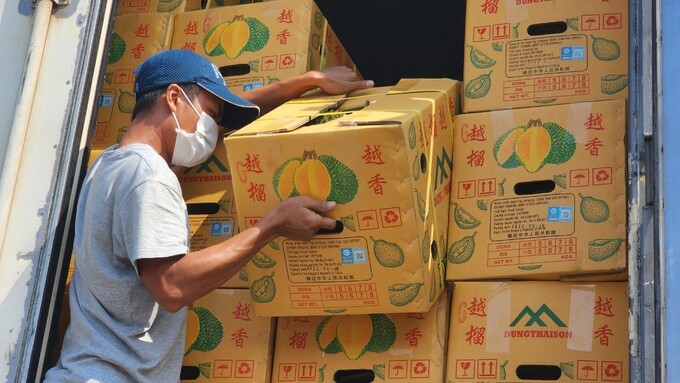(VOVWORLD) -The first truck loads of durians were exported to China last September via the Huu Nghi (Friendship) International Border Gate in Lang Son province. This paved the way for the fruit to finally be sold to China via official channels after years of negotiations. The initial success was achieved by farmers who changed their mindset out of a desire to bring Vietnamese durian to the world.
 A truck transporting durians from Dak Lak province on September 17 to Huu Nghi (Friendship) international border gate on September 19, 2023. (Photo: Van Viet) A truck transporting durians from Dak Lak province on September 17 to Huu Nghi (Friendship) international border gate on September 19, 2023. (Photo: Van Viet) |
-“Last year the export price increased 15% to 20% because it was exported through official channels. Hopefully in the future the price and market will be stable, so farmers can feel secure and their lives will improve.”
-“In the past, incomes weren’t stable because prices fluctuated. Sometimes they were too high, sometimes too low. Now exporting through official channels makes us feel very secure. This year their income was 10% to 20% higher than last year. Some incomes even doubled.”
-“All of us were encouraged by the recent signing of export contracts through official channels and the attention of local authorities. Our happiness has multiplied.”
That’s the thoughts of the farmers who grow durians in Ea Yong commune, Krong Pak district, Dak Lak province. They are the first to export durians to China under the protocol signed last September.
Tran Van Chien of Jung hamlet in Ea Yong commune grew 90 tons of durians in one year on 4.7 hectares. After 18 years of difficulties, this year Chien and his family had a bumper crop. He said that he felt even happier when China agreed to import Vietnamese durian and the prices doubled or tripled.
“Now durian is exported via official channels so my family has to farm methodically. The current trend is to produce to meet the demand of the consumers, rather than growing whatever the farmers want to grow. Quality must be the top priority,” said Chien.
Over the years, Chien and many other farmers worried about their yield and the price of durians every harvest. Following the VietGap standard and the protocol on phytosanitary requirements between Vietnam and China, and obtaining growing area codes, their fruit fetches higher prices with a more stable output. Now their farming is no longer random but follows a set technical process.
Chien recalled he used to farm unprofessionally but now has used technology, maintained a suitable farming environment, and changed his farming practices. “In the past, I could spray pesticides freely. Now the VietGap standards regulate the right fertilizers and the right preservation and harvest times,” said Chien.
Like Chien, Vu Thi Minh Tam of Ea Yong commune in Krong Pak district has been farming for nearly 20 years, but a less systematic approach made crop quality, price, and yield a headache. This year, Tam exported about 17 tons and earned a good profit. Since they were given a growing area code, the technical standards from planting to caring and harvesting are much stricter.
She said, “I’m one of the farmers in this growing code area asked to control epidemic diseases throughout the entire production cycle until the product is exported. During that cycle, VietGap's technical standards must be applied. Every year, fertilizers must be sprayed controllably and fields must be cleaned. Every step must comply with the standards.”
The signing of the protocol creates clear legal conditions and motivates farmers to farm professionally and on a larger scale, said Tam, adding farmers are excited and determined to follow the program to maximize quality and safety.
“I often tell the farmers in my group to strictly follow the required steps so their products can be exported. Of course, people always hope to export as much as possible at stable prices. We strictly follow the standards to export as much as possible to other markets, not just China. Basically, we want to give customers products of top quality and safety,” according to Tam.
Farmers in Dak Lak have escaped poverty, become better-off, and contributed to the building of a national durian brand known around the world.